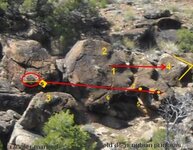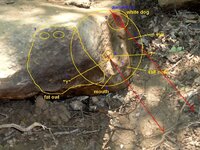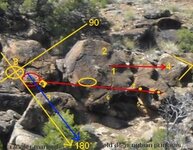treasurechest
Full Member
Soooo, can the topic or "class" resume now? 
Follow along with the video below to see how to install our site as a web app on your home screen.
Note: This feature may not be available in some browsers.
Springfield said:Pala Y Pico said:... This is ranglers thread, he gave his thoughs as to how he wanted it to work. ....
It's my understanding that this is a public forum operated by TreasureNet. Perhaps rangler ought to start up his own blog - then he could accept/reject whomever he wishes.

rangler said:as far as bit - I would argue that his work was incorrect, and did not see the reasoning behind his solution.






Let me help you. A 'basic' treasure sign is a rabbit hole. An 'advanced' treasure sign is found inside the rabbit hole.Hoss KGC said:So I guess I never understood the difference between an "advanced" treasure sign and a "basic" treasure sign?
sun ,time ,light airrangler said:springfield,
you had stated in reply...You are contradicting yourself and destroying the logic of your premise.
Now you are saying the miners removed the gold and left the silver. 'That is why the caches are small'. Historically (not today) silver was worth 1/16th the value of gold. That means even at 20%, your silver cache was twice the size of the gold removed. [1] That of course assumes the mine produced both gold and silver that was separatable with the technology available at the time. This was impossible unless a mine was located that produced both oxide-rich gold ore that could have been rough-smelted and native silver that could have been separately extracted from the same deposit. Hint: this combination has never been reported. [2] Your observation that rough-smelted gold ingots from your assumed time period often contained significant amounts of silver is definitely correct, but they also frequently contained even more copper. Who got the copper?
Another couple questions - for you too, Old Dog. [3] With the king's masons on hand to mark the king's caches, presumably the most important share (you know, 'pain of Spain'), why did they leave it behind? Are you claiming that the miners brought home their 80% and abandoned the king's share back in the wilderness, even though the king's specially trained people were along for the ride? Please explain why the king didn't demand delivery of his property. Second - if what you claim is true, why didn't the king send his people back to recover his share later? Seems simple - his men marked it and buried it, didn't they? Would have been easy.
No, sorry guys, none of this makes sense no matter how you try to spin it. I should know, because I tried to make it work in my mind too 30 years ago. It doesn't work (and I think you know it doesn't). We are finding carvings, monuments and other signs - yes indeed. They are cleverly executed, yes. They can be associated with additional signs, definitely. However, with fewer exceptions than you could count on your fingers (if even that many), these clues are not Spanish era. You guys are on a mysterious trail no doubt - but it is not the King's Trail. The sooner you realize this, the better.
[1]Now you are saying the miners removed the gold and left the silver. 'That is why the caches are small'. Historically (not today) silver was worth 1/16th the value of gold. That means even at 20%, your silver cache was twice the size of the gold removed.
that was the point of "paying a parking ticket with pennies" comment, the silver being more bulky than the gold but still 'coin of the realm'...the thinking was, let the kings mens and their crew and gear, take these tons of silver to the coast and the galleons.
a clever way to pay the price in the accord with the king, and get away clean with just the gold bars.
[2]Your observation that rough-smelted gold ingots from your assumed time period often contained significant amounts of silver is definitely correct, but they also frequently contained even more copper. Who got the copper?
A. copper mixed with gold would be rated as 18k not 24 with appox 25% copper/75% gold
[3] that was my assertion not old dogs, you are seeing this in a myopic way...there was a separation of these players...the mason worked for wages, the others a percentage...the jesuits were there with the with maps and plans.
They had free reign, there where in the early days and later in the more isolated places no one else there to molest them...they prospected, they mined, the smelted,they paid the quint, built the monument, buried same...shipped the goods to the pope...who has a lovely basement all a glitter.....years later even decades later, sometimes even centuries separated the mines and the kings men recovery crew.
You might not believe the above scenario, but you can disprove it either.
I work day to day decoding monuments now numbering in the hundreds
the code is clear if you know. and graffiti filled if you dont.
rangler
i think this means air all right but the air that comes in a pozo!!

 ....
....  ... Should we really believe that no one cheated on the "Kings Rules" when he was "way over there"? Many bank robbers horse thieves, etc. in more modern times knew they would be hung if caught....sometimes for only a few dollars. (human nature seems to indicate that when ....$... are involved some will always cheat a little bit? .. and the Church and Politicians are not exempt)
... Should we really believe that no one cheated on the "Kings Rules" when he was "way over there"? Many bank robbers horse thieves, etc. in more modern times knew they would be hung if caught....sometimes for only a few dollars. (human nature seems to indicate that when ....$... are involved some will always cheat a little bit? .. and the Church and Politicians are not exempt)